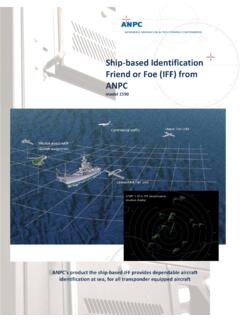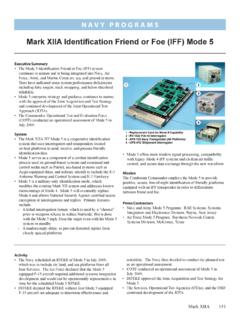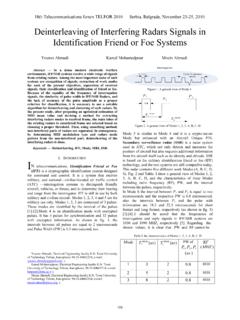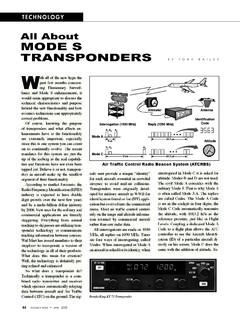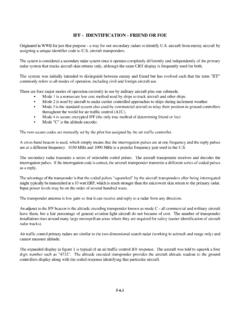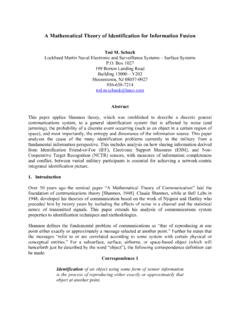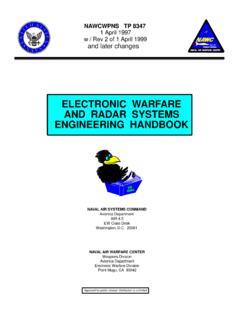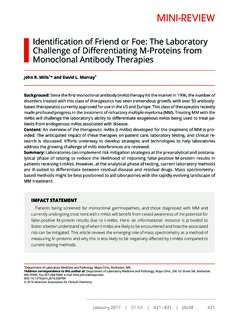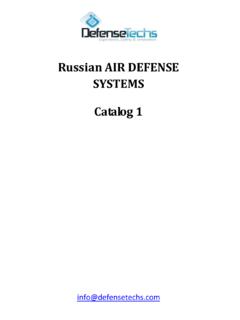Transcription of PLAN(U) JOINT TEST NM IDENTIFICATION FRIEND FOE OR …
1 AD-A141 554 PROGRAM MASTER PLAN(U) JOINT TEST FORCE KIRTLAND AFB NMIDENTIFICATION FRIEND FOE OR NEUTRAL JAN 84 UNCLASSIFIED F/G 17/2 1-64 I *,f- -MICROCOPY RESOLUTION TEST CHARTNATIONAL BUJREAU Of STANDARDS- 163-APROGRAM MASTER PLAN0F-C-,IIII JANUARY !!!MW1ON -STATEMENT --A -Appoweud ftx public zeleaselDistdbutdcU Unlimited84 04 2 4 RECORD OF CHANGESC hange Title or Entered by/ Date ofNo Date Brief Description Initials EntryTable of Program Objectives, Issues, and Major Operational Issue Major Operational Issue Operational Testing Testbed Participating JOINT Test JTF JTF JOINT Test Deputy Test Service General Air Force Army Institute for Defense Analyses (IDA)
2 IFFN ETS Development Technical Support IV&V NATO Interface with Related Activities and Combat IDENTIFICATION System Program NATO IDENTIFICATION System Program Other Related Documentation System Developmental Facilities and LPU Test Concept of Test Concept of Operations for Test ETS Concept of M ITable of Contents (cont) Test Execution Representation of Test Test Operations Resource Personnel Resource Military Civilian Equipment and Host/Tenant Testbed Overview of Testbed Acquisition Acquisition Testbed Design Testbed Central Simulation System/Support Data Satellite Simulation ETS Communications ETS Software Pretest Scenario Posttest Analysis and Real Time Configuration Baseline Baseline Functional Allocated Product Testbed Acquisition Acquisition Contract Independent Verification & Validation Technical Support Testbed Acquisition Acquisition Program Deputy Program Technical Representative to the Contracting Contracting Officer
3 3TF In-Plant Acquisition Management Stage Quality ..Table of Contents (cont) Configuration Functional Area Testbed ApproachAppendix A. ReferencesAppendix B. Sequence of Test SeriesAppendix C. Budget ProfileAppendix D. Acquisition ScheduleAppendix E. Master ScheduleAppendix F. Service Resource RequirementsAppendix G. AcronymsAppendix H. Model Development ProcessAccession For1 NTIS GRA&IDTIC TAB 13 Unaunounced 0lIfiBy , Distribution/: ~Availabilitt Codes .. _Dst Spec Program Authority: The IDENTIFICATION FRIEND , Foe, or Neutral JOINT Test andEvaluation IFFN JT&E) is directed by the Director, Defense Test and Evaluation,Office of the Under Secretary of Defense for Research and Engineering(OUSDRE/DDT&E) through the Chrter of the JOINT Test Director, 12 July 1979, asapproved by the Assistant Secret is for the Air Force, Army, and Navy andimplemented by the Air Force Tes, Directive thru HQ United States Air Forcemessage DTG 162030Z Jul Purpose -4he purpose of theiFFN JT&Egis to assess baseline US capabilitieswithin the North Atlantic Treaty Organization (NATO) air defense command andcontrol (C2)
4 System to perform the IFFN function, identify deficiencies in theperformance of that function, and propose potential near-term procedural andequipment modifications for further testing. The purpose of this document is toserve as an internal management tool, provide an overview of the objectives,background, concept of execution, resource requirements, and acquisition conceptof the IFFN JT&E and to provide an umbrella document identifying the roles ofall participating Background: It is widely recognized that the inability of operators of airdefense systems to discriminate accurately and rapidly between friendly, hostileand neutral aircraft significantly limits the effective utilization of these recognition has stimulated activity within NATO to develop an effectiveNATO IDENTIFICATION System (NIS).
5 In 1975 the Defense Science Board issued a report detailing problemsassociated with target IDENTIFICATION for employment of beyond-visual-range (BVR)air defense weapons. Based on their report, the Deputy Secretary of Defensedirected the JOINT Chiefs of Staff (JCS) to incorporate the evaluation of theidentification function into field exercises and the Office of the Secretary ofDefense (OSD) to integrate the IDENTIFICATION function with the C2 process bothorganizationally and Institute for Defense Analyses (IDA) was tasked to further study theseissues. IDA recommended establishing the IFFN JT&E program. In July 1979, theDDT&E issued the Charter for the IDENTIFICATION , FRIEND , Foe, Neutral JOINT Testand Evaluation Program naming the Air Force as the Executive Service andincluded requirements for Air Force, Army, and Navy Deputy Test Directors to beassigned to the JOINT Test Force (JTF) located at Kirtland Air Force Base, NewMexico.
6 IDA has been tasked by DDT&E to develop the test concept and designwhich will be coordinated with the services and the JOINT Test Director (JTD). Objectives. Issues, and ObjectivesDuring the test planning phase, specific objectives along withappropriate methodology, measures of effectiveness, measures of performance, anddata elements will be developed to satisfy the issues identified IssuesThe IFFN 3T&E will address the two major operational issues identified,+Ibelow. A more thorough discussion of the two major issues to include theirsupporting rationale and additional specific issues is contained in the IFFN TestConcept Paper and will be further amplified in the Field Test Major Operational Issue 1.
7 What is the contribution of indirectidentification information to the ability of US air defense command and controlsystems operating in NATO to correctly identify airborne targets, useidentification in performing target allocation, and aid subordinate air defenseweapons systems in performing target acquisition? Major Operational Issue 2. What are the weaknesses in the collection,formation, dissemination, and use of indirect IDENTIFICATION information for whichsolutions are not currently planned? Impacta. Satisfying the first major operational issue will provide a baselineassessment of the expected IDENTIFICATION performance of a representative airdefense system operating in the Fourth Allied Tactical Air Force (4 ATAF) area in awartime environment, with results applicable to other JOINT and combinedenvironments.
8 It will also provide a fuller understanding of the relationship ofidentification performance of the command and control system to the performanceof the overall active air defense mission. This understanding should also provide anempirical data base which can assist the Services and OSD in the formulation ofverification of operational requirements for IDENTIFICATION and point to possibleweaknesses in projected "baseline" Satisfying the second major operational issue will identifyweaknesses in the IDENTIFICATION process and allow for a qualitative comparison ofweaknesses identified during testing, with existing programmed solutions for theseweaknesses (Service, OSD, and NATO input of ongoing and proposed identificationprogram information being required to conduct this comparison).
9 It should also bepossible to postulate potential corrective actions for those deficiencies that areidentified that currently lack a programmed solution. These recommendedcorrective actions could take the form of doctrinal or procedural changes, systemsoftware changes, communications connectivity changes, addition of new datasources, or various combinations of these remedies. Upon Service and OSD reviewof these recommendations and their subsequent input of additional test issues,follow-on testing can be proposed, scheduled, and conducted using the [FFNT estbed and acquired data base for Operational Testinx ConceptThe concept for operational testing under the IFFN JT&E program is toreplicate, through a computerized testbed, those operational weapon and commandand control system configurations which will be in the field in the 1 985-1 986 time-f of the test objectives involves two major facets:a.]
10 Development of the Evaluation Testbed System (ETS)b. Conduct of testing2In order to minimize technical and program risks, a phased testbedacquisition has been adopted and is further explained in Section test approach is based on seven series of testing. The series will consistof the following weapons systems, command and control systems, and associateddata links:a. Series 1: System CheckoutPATRIOT Fire Unit (FU)PATRIOT Air Defense Information Language (PADIL)b. Series 2: PATRIOT FUPATRIOT Battalion Fire Direction Center (Bn FDC)PADILc. Series 3: PATRIOT FUPATRIOT Bn FDCPATRIOT Brigade Fire Direction Center (Bde FDC)PADILArmy Tactical Data Link -I (ATDL I)d. Series 4: F-15 "Eagle" Interceptore. Series 5: F-15 USAF Control and Reporting Post/Message ProcessingCenter (CRP/MPC)NATO Airborne Early Warning System (NE-3A)Special Information System (SIS)TADIL-ATADIL-Bf.










